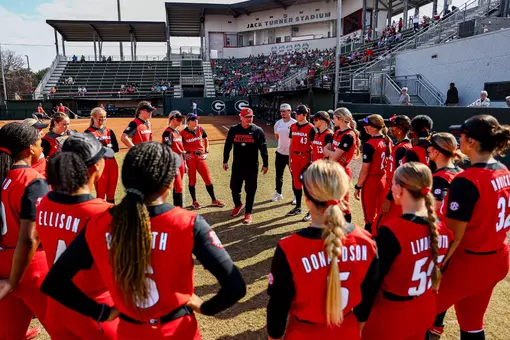University of Georgia Athletics
Sumerlin Comfortable Not Swinging
March 30, 2017 | Softball
By John Frierson
UGAAA Staff Writer
There's an art to hitting, of course. There may also be an art, or at least science, to not swinging the bat.
Georgia softball's Lacey Sumerlin swings and connects for hits plenty — after Wednesday's 8-0 win over Georgia Southern the sophomore shortstop and cleanup hitter is batting .316 — but she also knows when not to swing. And doesn't hesitate to keep the bat on her shoulder.
"At this level of the game, pitchers aren't going to give you great pitches to hit," she said. "If they can get you to swing at their junk, they're going to get you to swing out of the zone."
Sumerlin has drawn three walks in a game three times this season and two walks four times. She drove in a run Wednesday with a bases-loaded walk, one of her two walks in the game. Sumerlin is up to 32 walks this season and will likely at least double her total from 2016, when she had 19.
The rise in walks and the huge jump in her batting average, she hit .235 as a freshman, are certainly related. She's a better, smarter and more patient hitter this season — one that seldom swings at "junk."
"Going into my second year, I can recognize pitches better and just not being a freshman you feel more calm out there," she said.
One reason Sumerlin is good at drawing walks, associate head coach Tony Baldwin said, is because she understands from experience what the pitcher is thinking.
"She was a really good pitcher in high school, so she understands that not every pitch is intended to be a strike," Baldwin said. "Not everybody understands, 'Hey, what are they trying to do here? What do they want me to do?' She has a pretty good feel for that."
So do former pitchers make for smarter, more discerning hitters?
"I think it can make them smarter, for sure," he said. "Once they understand the strategy behind it, then you can start to formulate a plan from the other side."
And every at-bat, sophomore Alyssa DiCarlo said, is a bit of a mind game between the pitcher and batter.
"You have to think about the situation and maybe where you're going to get pitched," said DiCarlo, who has drawn 21 walks and leads Georgia with eight home runs and 42 RBIs. "If there's a runner on third they're not going to throw you [outside], they're going to throw you in so you hit it to the third baseman, hold the runner and they get the out.
"If you go up there thinking that I'm going to swing at everything, you're going to get yourself out."
In the second inning against Georgia Southern, Sumerlin led of with a walk. She later scored on an Alysen Febrey line-drive double to center-field.
In the third with Cortni and Sydni Emanuel on the corners, DiCarlo walked to load the bases. Sumerlin, stepping in with the bases packed and nobody out — prime swing-for-the-fences time for a player that already has two grand slams this season — Sumerlin worked the count to 3-2 and then took ball four and the RBI, which put Georgia up 3-0.
"In that situation, as a hitter, I want to hit the ball — but I'm not going to get myself out on her pitch because she wants to expand the zone," she said. "If I start swinging at her junk outside of the strike zone then we won't get one run or any runs out of that.
"You just have to stay calm and trust your eyes in that situation."
The eyes, the fast-twitch muscles and the mechanics of the swing all play into a batter being able to see what's coming and check the swing if needed, Baldwin said. Staying in sequence on a swing is critical.
"The swing is a big sequence and the longer you stay in sequence the longer you can stop your swing," he said, using as an example how Tiger Woods in his prime famously was able to stop his powerful swing inches from the ball if he heard something distracting like a camera shutter opening and closing.
DiCarlo and Sumerlin are Georgia's Nos. 3 and 4 hitters and frequently step into the batter's box with runners on base. That's because the Emanuel sisters bat first and second, and they're both are hitting above .440 and get on base better than 49 percent of the time. Those are precious at-bats for Georgia's top two run produces and they can't be wasted with undisciplined swings.
"At the beginning of the year I kind of struggled with that, because I was swinging at pitches that they wanted me to swing at," DiCarlo said. "I had to shift my mindset to think that I'm probably not going to get a lot of good pitches in my at-bat, so I had to learn to be a little more selective.
"It's gets easier knowing that, in my situation, there's hitters like Lacey and [Maeve McGuire] behind me, that can do the same thing that I can do. If I don't drive in the runs, if I just get on base, there's someone behind me that's going to do the job."
John Frierson is the staff writer for the UGA Athletic Association and curator of the ITA Men's Tennis Hall of Fame. You can find his work at: Frierson Files. He's also on Twitter: @FriersonFiles and @ITAHallofFame.









